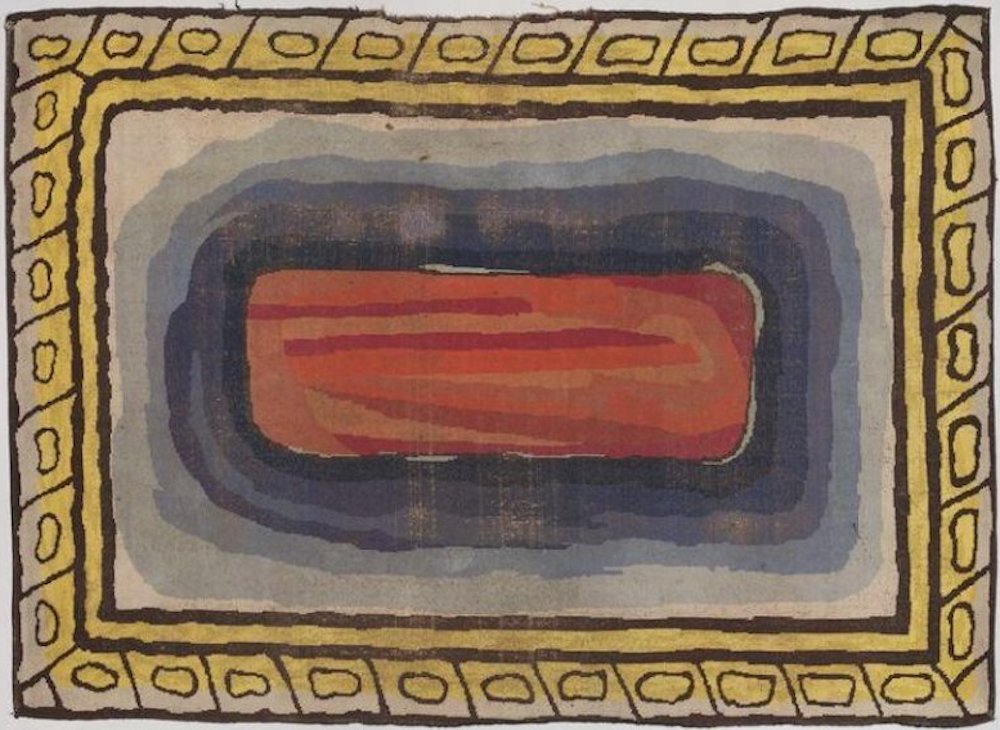
ARTIST CARPETS & RUGS: DUNCAN GRANT
Image: 'The Pool of Blood Carpet'. Image courtesy of Victoria and Albert Museum, London
By Deborah Nash
In 1913, the painter and art critic Roger Fry founded the Omega Workshops Ltd at 33 Fitzroy Square, London, to give his artist friends – many belonging to the Bloomsbury Group - a regular income by decorating household objects for the homes of wealthy patrons. Among the Omega Workshop members were the painters and co-directors Duncan Grant (1885-1978) and Vanessa Bell, plus Frederick Etchells, Edward Wolfe, Winifred Gill, Henri Gaudier-Brzeska - and, to begin with - Wyndham Lewis.
Inspired by contemporary art in Europe, particularly Fauvism and Cubism, which had been promoted by Roger Fry in two exhibitions in 1910 and 1912, these artists created furnishing and dress fabrics, murals, ceramics, glass, rugs and carpets in startling fresh abstract patterns and colours, shaking up the fusty heavy interiors of Edwardian England, which Fry had dismissed as typical of ‘Birds Custard Isle’.

Image: Close up of proper left corner of 'The Pool of Blood Carpet'. Image courtesy of Victoria and Albert Museum, London
Duncan Grant’s carpet, ‘The Pool of Blood’ is hand-knotted with wool pile (L: 402cm x W: 292cm). It stands in bold opposition to the floral surfaces of, say, William Morris, and also seems to encapsulate the looming shadow of war in 1914. As a conscientious objector, Grant later avoided conscription by removing himself to Sussex to work on a farm in 1916. The design was woven by the long-standing Wilton Royal Carpet Factory in Wiltshire and purchased by a moneyed cultured couple living in London’s Holland Park, George and Margaret Booth, who were known for their ‘go-ahead’ taste. The title ‘The Pool of Blood’ was given rather ominously by the couple’s children.
The carpet’s central motif of a floating oblong soap-bar of red, pink and orange, with bands of blue-grey rippling out to a wide frame of lozenges containing decorative corpuscle shapes make me think of a tiled Roman bath or indeed the rectangular goldfish pond in Roger Fry’s garden, which was later replicated at Grant’s and Bell’s Charleston farmhouse. As a carpet, it becomes a territory, a piece of land with a defined border, while a pool suggests the instability of liquid.

Image: Close up of the central motif of 'The Pool of Blood Carpet'. Image courtesy of Victoria and Albert Museum, London
The instability of the era saw the end of the Omega Workshops in 1919, financial mismanagement cited as the cause of its demise but undoubtedly the First World War had played its part. Even so, interest in the work of this short-lived collective continues to flourish.
SAVE THE DATE: Upcoming Selvedge online talk, Rugs, Wednesday 12 April 2023 at 18:00 BST (British Summer Time).
By Deborah Nash
In 1913, the painter and art critic Roger Fry founded the Omega Workshops Ltd at 33 Fitzroy Square, London, to give his artist friends – many belonging to the Bloomsbury Group - a regular income by decorating household objects for the homes of wealthy patrons. Among the Omega Workshop members were the painters and co-directors Duncan Grant (1885-1978) and Vanessa Bell, plus Frederick Etchells, Edward Wolfe, Winifred Gill, Henri Gaudier-Brzeska - and, to begin with - Wyndham Lewis.
Inspired by contemporary art in Europe, particularly Fauvism and Cubism, which had been promoted by Roger Fry in two exhibitions in 1910 and 1912, these artists created furnishing and dress fabrics, murals, ceramics, glass, rugs and carpets in startling fresh abstract patterns and colours, shaking up the fusty heavy interiors of Edwardian England, which Fry had dismissed as typical of ‘Birds Custard Isle’.

Image: Close up of proper left corner of 'The Pool of Blood Carpet'. Image courtesy of Victoria and Albert Museum, London
Duncan Grant’s carpet, ‘The Pool of Blood’ is hand-knotted with wool pile (L: 402cm x W: 292cm). It stands in bold opposition to the floral surfaces of, say, William Morris, and also seems to encapsulate the looming shadow of war in 1914. As a conscientious objector, Grant later avoided conscription by removing himself to Sussex to work on a farm in 1916. The design was woven by the long-standing Wilton Royal Carpet Factory in Wiltshire and purchased by a moneyed cultured couple living in London’s Holland Park, George and Margaret Booth, who were known for their ‘go-ahead’ taste. The title ‘The Pool of Blood’ was given rather ominously by the couple’s children.
The carpet’s central motif of a floating oblong soap-bar of red, pink and orange, with bands of blue-grey rippling out to a wide frame of lozenges containing decorative corpuscle shapes make me think of a tiled Roman bath or indeed the rectangular goldfish pond in Roger Fry’s garden, which was later replicated at Grant’s and Bell’s Charleston farmhouse. As a carpet, it becomes a territory, a piece of land with a defined border, while a pool suggests the instability of liquid.

Image: Close up of the central motif of 'The Pool of Blood Carpet'. Image courtesy of Victoria and Albert Museum, London
The instability of the era saw the end of the Omega Workshops in 1919, financial mismanagement cited as the cause of its demise but undoubtedly the First World War had played its part. Even so, interest in the work of this short-lived collective continues to flourish.
SAVE THE DATE: Upcoming Selvedge online talk, Rugs, Wednesday 12 April 2023 at 18:00 BST (British Summer Time).
